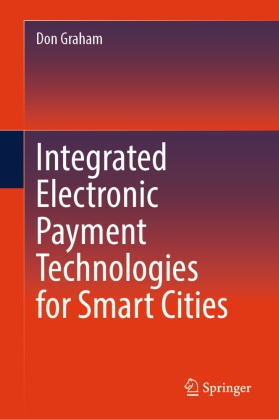
Integrated Electronic Payment Technologies for Smart Cities
| Verlag | Springer |
| Auflage | 2023 |
| Seiten | 176 |
| Format | 23,5 cm |
| Gewicht | 494 g |
| Artikeltyp | Englisches Buch |
| ISBN-10 | 3031382218 |
| EAN | 9783031382215 |
| Bestell-Nr | 03138221A |
This book addresses the use of existing and emerging electronic payment technologies within a smart city in the context of the clear and proven value these systems have demonstrated in improving transportation. It addresses such question as How does the toll gantry work? How does it read the transponder tag and deduct the correct amount? How do cities harness the transaction data from mass transit to better meet the demand during peak hours? What can city planners do to make trip scheduling and payments seamless, so commuters can go from park-and-ride to mass transit to ride-share with a single payment platform? The volume is technical in nature and describes solid technical solutions to engineers and planners associated with smart cities initiatives. It is specifically designed to support smart city designers and engineers as they develop strategies that incorporate the latest payment system technologies. It will also be of value to private sector payment systems solution pro viders looking to deliver their products and services to smart cities. In addition, the book supplements technical perspectives with guidance on planning and implementation. For example, it defines procurement approaches for emerging technologies such as crypto currencies and block chain. Rounding out technical detail with advice on policy and the organizational framework required to underpin the technologies, the book delivers practical support to smart city technical practitioners. It further stands as an appropriate text for university courses associated with smart city planning, operations, and urban analytics.
This book explores these questions and provides answers that a typical transportation planner can follow. It covers technology topics such as RFID (Radio Frequency ID), ETC (Electronic Toll collection), and ANPR (Automatic Number Plate Recognition). The book also delves into how contactless payment (Near-Field) technologies can be used in a smart city. Blockcha in is introduced as a platform that is suitable for solving the problem of payment segregation and shows how the entities in a smart city can work together to provide a seamless payment solution for riders across different modes of transport.
The book also covers some theoretical concepts of congestion pricing which students at the university level can apply to city planning projects and research into smart cities.
Several examples of US-based and international smart city implementations are provided in the closing chapters which demonstrate new, innovative smart city techniques for the transportation planner.
Inhaltsverzeichnis:
Chapter 1. Introduction to Smart Cities.- Chapter 2. Payment Technologies in the Smart City Context.- Chapter 3. Electronic Toll Collections and Smart City Payments.- Chapter 4. Smart City Implementation Challenges and Opportunities.- Chapter 5. Smart City Innovations in integrated Payment Technologies.- Chapter 6. The use of integrated payment technologies in smart city transportation pricing strategies.- Chapter 7. How analytics can be used to guide smart city strategies.- Chapter 8. Practical application of smart city strategies.- Chapter 9. Blockchain and Digital Currency.- Chapter 10. Implementing digital payments in Smart Cities.- Chapter 11. National and International Smart City Applications.- Chapter 12. Summary.
